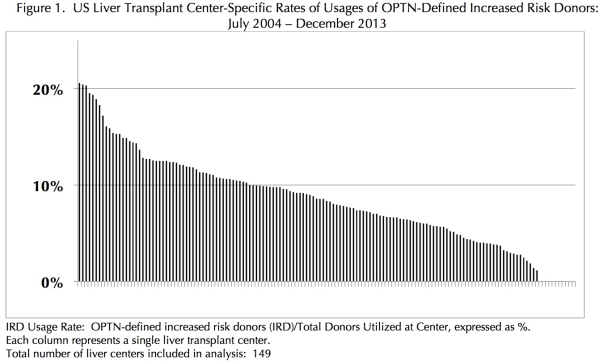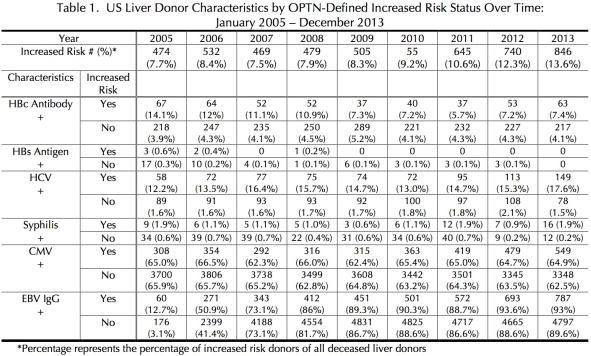Utilization and Characteristics of Liver Donors in the US by OPTN-Defined Increased Risk Donor Status
1Infectious Diseases, Northwestern University, Chicago
2Organ Transplantation, Northwestern University, Chicago.
Meeting: 2015 American Transplant Congress
Abstract number: C129
Session Information
Session Name: Poster Session C: Liver Donation and Allocation
Session Type: Poster Session
Date: Monday, May 4, 2015
Session Time: 5:30pm-6:30pm
 Presentation Time: 5:30pm-6:30pm
Presentation Time: 5:30pm-6:30pm
Location: Exhibit Hall E
Background: The number of candidates in need of liver transplantation is far larger than the number of organ donors. To expand the organ pool, there has been increased used of OPTN-defined increased risk (IR) donors (D). The utilization and epidemiology of infectious disease marker positivity of these IR liver donors has not been previously described.
Methods: We obtained data from the US OPTN to perform a blinded assessment of liver transplant center-specific utilization of OPTN-defined increased risk donors. We evaluated the epidemiology of infectious disease marker positivity of liver IRDs and non-IRDs from July 2004 – December 2014. Student's T-test was used to compare groups.
Results: IRDs accounted for 7.5 – 13.6% of liver donors during the study period (see Table 1) and there was a trend towards increased utilization of IRDs over time. Of the 149 US liver transplant centers, 63 (42.3%) had ≥ 10% utilization of IRDs while 11 (7.4%) did not utilize any OPTN-defined IRDs during the 8.5 years studied (See Figure 1). IR liver donors were more likely to be seropositive for HBcAb (p = 0.0012) and HCV (p < 0.001) and have a reactive syphilis screening test (p = 0.029).
Conclusions: The OPTN-defined liver IRDs were more likely to have positive HBcAb, HCV and syphilis screening. While there is significant variability in the use of OPTN-defined IRDs by US liver transplant centers, utilization of IRD livers is generally higher than non-liver organs. Further analysis is ongoing to assess the outcomes of both groups.


To cite this abstract in AMA style:
Ison M, Abecassis M, Ladner D. Utilization and Characteristics of Liver Donors in the US by OPTN-Defined Increased Risk Donor Status [abstract]. Am J Transplant. 2015; 15 (suppl 3). https://atcmeetingabstracts.com/abstract/utilization-and-characteristics-of-liver-donors-in-the-us-by-optn-defined-increased-risk-donor-status/. Accessed December 19, 2025.« Back to 2015 American Transplant Congress
